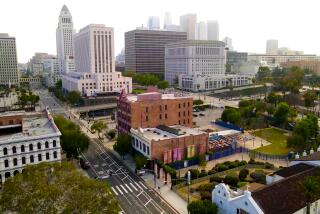Digging, Tests Begin at Site for Cathedral
- Share via
Under overcast skies, a large yellow backhoe peeled away chunks of gray asphalt early Monday in a downtown Los Angeles parking lot, beginning one of the most politically sensitive portions of the multimillion-dollar effort to build a new cathedral for the nation’s largest Roman Catholic archdiocese.
Archeological testing began to determine what, if any, “significant cultural resources,” including human remains or artifacts, may be resting in the soil of the 5.8-acre site that eventually will house the cathedral complex for the Roman Catholic Archdiocese of Los Angeles.
Some Native Americans have expressed concern that the site, which runs along Temple Street from Grand Avenue to Hill Street and overlooks the Hollywood Freeway, may house an ancient burial ground. Two groups have filed suit, hoping ultimately to block the construction project.
No one showed up to protest Monday’s activities, which marked the first significant earth movement in the $100-million-plus effort.
Kathy Knight, with the Spirit of the Sage Council, one of the plaintiffs in the suit against the archdiocese, issued a harshly worded news release late Monday, saying she “just can’t believe” that the archdiocese moved ahead with the digging three days before a court hearing seeking a preliminary injunction in the case.
Near the close of work Monday, archeologist Donn Grenda said there had been no archeologically significant finds, only some old railroad ties, part of a sewer pipe and a piece of a malted milk bottle.
“We’re looking at the only portion of the site that has any real chance of having a prehistoric site in it, and we have not found that yet,” said Grenda, with the Tucson-based Statistical Research Inc.
But there was more ground to be uncovered.
For this phase of the project, workers are digging past any fill dirt to “native soil” in eight or nine trenches in roughly the eastern half of the parking lot, near the corner of Temple and Hill. That’s the general area where bones, later determined to be those of a Native American, were discovered during a late 1950s construction project.
The overall significance of that find--which included part of a skull and parts of a left arm--is at the heart of the dispute between some Native Americans and the archdiocese.
Plaintiff Vera Rocha, who says she is the hereditary chief of the Gabrielino band of California (Shoshone) Mission Indians, said she believes that the area was once a sacred burial ground.
“I just want the development of the area to stop,” Rocha said in an earlier interview.
“They’re destroying a part of our history. That earth holds the blood and flesh in the ashes.”
The archdiocese has long maintained that the bones were found in fill that was apparently trucked in to the site years ago, from an unknown location, to plug an underground tunnel once used by the Red Car trolley line.
However, Robert Lavenberg, an official with the Los Angeles County Museum of Natural History, where the bones have been kept since the 1950s, quoted from records made at the time indicating that the skull, at least, was found 2 feet below the fill area.
“The skull was found 11 feet down,” said Lavenberg, adding that according to his records the fill, or “overburden,” dirt went down 9 feet.
Engineers working on the project have placed the fill depth at 16 feet--the depth to which workers this week will dig in the largest of the trenches, John McNicholas, one of the attorneys handling the suit for the archdiocese, said Monday.
“We’ll never know whether the remains were brought in from another site,” Lavenberg said. “That’s going to just plague us that we don’t know the answer to that question.”
If anything is found, McNicholas said, it will be “treated with the greatest of respect.”
Brother Hilarion O’Connor, director of construction for the archdiocese, estimated that the testing project would last through early April, with work starting on the western end of the site March 30.
If the project moves forward, the area under scrutiny Monday will house a three-level 620-car parking structure that O’Connor said would be available for public use during the day and for events at the nearby Music Center.
More to Read
Sign up for Essential California
The most important California stories and recommendations in your inbox every morning.
You may occasionally receive promotional content from the Los Angeles Times.










